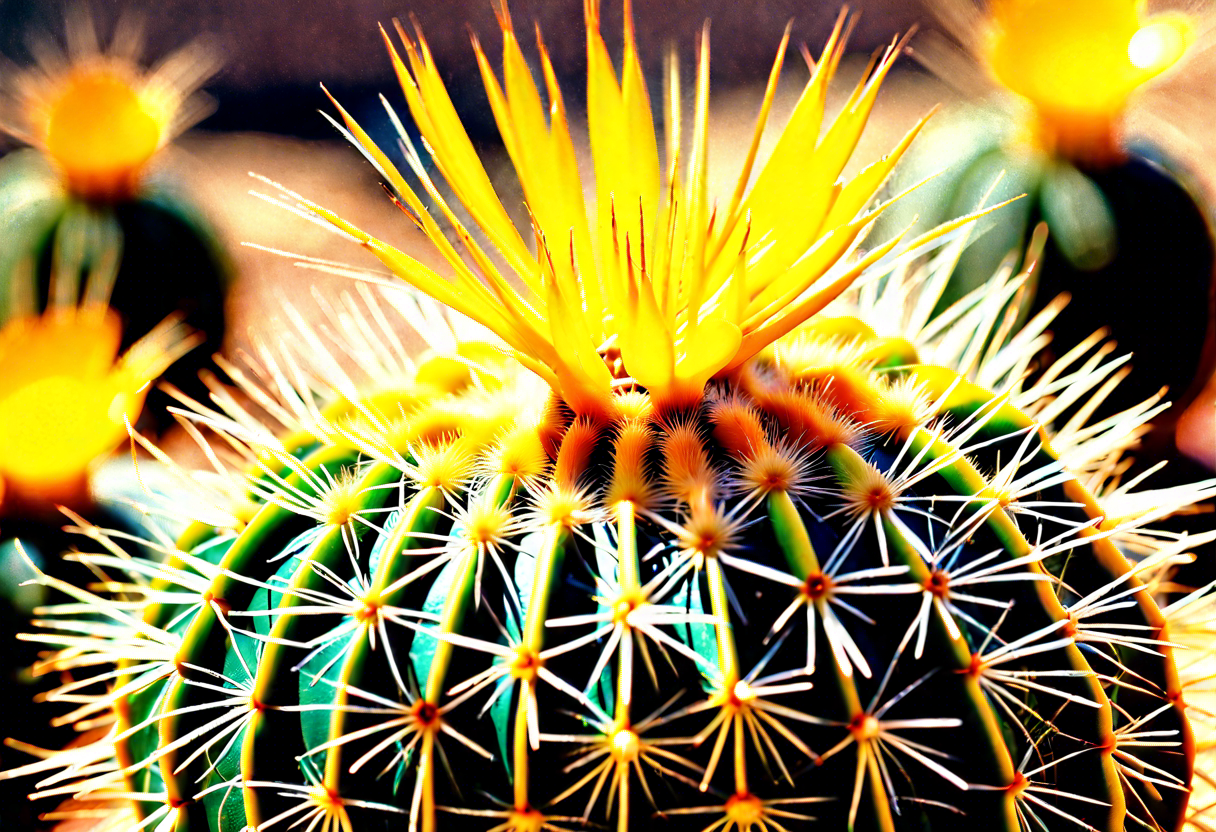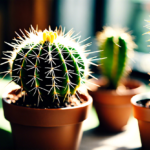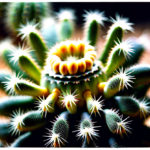Characteristics and Care of the Golden Barrel Cactus
The Golden Barrel Cactus (Echinocactus grusonii) is a striking cactus species native to Mexico. This popular ornamental cactus is known for its distinct golden-yellow, globe-shaped body covered in numerous spines. Its unique appearance makes it a sought-after plant for xeriscapes, rock gardens, and arid landscapes.
One of the key characteristics of the Golden Barrel Cactus is its slow growth rate. When provided with the right conditions, this cactus can grow up to 2 feet in height and diameter over several decades. Its bright yellow-green coloration and prominent ribs add to its visual appeal, making it a focal point in any garden setting.
Caring for the Golden Barrel Cactus requires attention to important factors such as sunlight, water, soil, and temperature. This cactus thrives in full sun, so it is essential to place it in a location where it can receive at least 6 hours of direct sunlight daily. In terms of watering, the Golden Barrel Cactus is drought-tolerant and should be watered sparingly to prevent root rot. It is crucial to allow the soil to dry out completely between waterings to mimic the plant’s natural desert habitat.
When it comes to soil, the Golden Barrel Cactus prefers well-draining soil to prevent waterlogging. A sandy or gritty cactus mix is ideal for providing the necessary drainage for the plant’s roots. Additionally, this cactus is sensitive to cold temperatures and should be protected from frost during the winter months. Providing a warm, sheltered location or moving the plant indoors during the coldest periods can help prevent cold damage.
The Golden Barrel Cactus is a stunning addition to any arid garden landscape, thanks to its unique appearance and low-maintenance care requirements. By ensuring adequate sunlight, proper watering, well-draining soil, and protection from frost, gardeners can enjoy the beauty of this iconic cactus for many years to come.
For more information on caring for Golden Barrel Cacti, visit CactusGuide for expert tips and advice.
Ideal Growing Conditions for Echinocactus grusonii
The Golden Barrel Cactus, scientifically known as Echinocactus grusonii, is a popular choice among succulent enthusiasts due to its striking appearance and low maintenance requirements. To ensure the healthy growth of these stunning cacti, it is essential to provide the ideal growing conditions that mimic their natural habitat.
Sunlight: Golden Barrel Cacti thrive in full sunlight. They require at least six hours of direct sunlight daily to maintain their compact and spherical shape. Placing them in a south or west-facing window where they can receive ample sunlight is crucial for their growth.
Soil: Well-draining soil is essential for preventing root rot in Echinocactus grusonii. A cactus mix or sandy soil works best for these plants. Adding pumice or perlite to the soil mixture can improve drainage and aeration, promoting healthy root development.
Watering: Golden Barrel Cacti are drought-tolerant plants that prefer infrequent but deep watering. During the growing season in spring and summer, water the cacti when the top inch of the soil is dry. In contrast, reduce watering in fall and winter to mimic their natural dormant period.
Temperature: These cacti thrive in warm temperatures ranging between 70°F to 100°F (21°C to 38°C). During the winter months, they can withstand cooler temperatures as low as 50°F (10°C). Protect them from extreme temperature fluctuations to prevent stress to the plants.
Humidity: Golden Barrel Cacti are adapted to low humidity environments and do not require any additional humidity to thrive. In fact, high humidity levels can lead to fungal diseases in these arid-adapted plants. Ensure good air circulation around the cacti to prevent any moisture-related issues.
Fertilization: Minimal fertilization is sufficient for Echinocactus grusonii. During the growing season, from spring to summer, fertilize the cacti with a diluted cactus fertilizer mix once a month. Avoid over-fertilizing, as it can lead to nutrient toxicity and damage the plants.
By providing the ideal growing conditions of ample sunlight, well-draining soil, proper watering, suitable temperatures, low humidity, and minimal fertilization, you can ensure the health and vitality of your Golden Barrel Cactus. Following these guidelines will help you create a thriving environment for your Echinocactus grusonii to flourish. For further information on caring for these unique cacti, you can refer to Succulent Alley’s care guide to enhance your knowledge and expertise in succulent gardening.
Landscaping Ideas with Golden Barrel Cacti
When it comes to landscaping with the magnificent Golden Barrel Cactus (Echinocactus grusonii), there are various creative ways to incorporate these stunning plants into your outdoor space. Whether you have a small garden, a spacious backyard, or even a balcony, Golden Barrel Cacti can add a touch of desert beauty to your landscape. Here are some landscaping ideas to inspire you:
1. Golden Barrel Cactus Garden: Create a dedicated Golden Barrel Cactus garden by planting several specimens together. You can arrange them in clusters or rows to showcase their unique spherical shape and golden spines. Add some decorative rocks and gravel around the cacti to enhance the desert vibe.
2. Rock Garden: Combine Golden Barrel Cacti with other desert plants like Agave and Yucca to design a stunning rock garden. Use different sizes and heights to create a visually appealing landscape. Incorporate boulders and driftwood for a natural look.
3. Container Garden: If you have limited space, plant Golden Barrel Cacti in decorative pots or containers. Place them on patios, balconies, or along walkways to add a pop of color and texture. Mix and match with other succulents for a diverse and eye-catching display.
4. Xeriscape Design: Opt for a xeriscape design that focuses on water conservation by using drought-tolerant plants like the Golden Barrel Cactus. Create a low-maintenance landscape that thrives in arid conditions while adding beauty to your surroundings.
5. Accent Plant: Use Golden Barrel Cacti as focal points or accent plants in your garden. Plant them strategically among shrubs or ornamental grasses to create contrast and visual interest. Their round shape and vibrant color make them stand out in any landscape.
By incorporating Golden Barrel Cacti into your landscaping design, you can create a unique and striking outdoor environment that celebrates the beauty of desert flora. Experiment with different arrangements, textures, and colors to transform your space into a desert oasis.
For more landscaping ideas and inspiration, visit Garden Design’s website.
Common Pests and Diseases Affecting Echinocactus grusonii
The Golden Barrel Cactus (Echinocactus grusonii) is a popular choice among cactus enthusiasts due to its striking appearance and low-maintenance requirements. However, like all plants, these cacti are susceptible to various pests and diseases that can affect their health and overall growth if not properly addressed.
One of the common pests that can infest Golden Barrel Cacti is the cactus bug. These small insects feed on the plant’s juices, causing wilting, yellowing, and stunted growth. To control cactus bugs, it is essential to regularly inspect the plants for any signs of infestation and treat them with insecticidal soap or neem oil.
Another troublesome pest for Echinocactus grusonii is the mealybug. These soft-bodied insects often hide in the crevices of the cactus and feed on its sap, leading to yellowing and distorted growth. To get rid of mealybugs, a solution of water and alcohol can be sprayed on the affected areas or a cotton swab dipped in alcohol can be used to remove them manually.
In addition to pests, Golden Barrel Cacti are also prone to diseases such as root rot caused by overwatering or poor drainage. Symptoms of root rot include mushy, blackened roots and a foul odor emanating from the soil. To prevent root rot, it is crucial to plant the cactus in well-draining soil and avoid overwatering, especially during the winter months when the plant is dormant.
Furthermore, fungal infections like powdery mildew can also affect Echinocactus grusonii, manifesting as a white powdery substance on the plant’s surface. To treat powdery mildew, affected areas can be sprayed with a mixture of water and baking soda or a fungicidal spray specifically formulated for cacti.
By being vigilant and proactive in identifying and addressing these common pests and diseases, cactus enthusiasts can ensure the health and longevity of their Golden Barrel Cacti. Regular inspections, proper watering practices, and timely treatments are key to keeping these iconic cacti thriving in both indoor and outdoor settings.
For more information on how to care for and protect Echinocactus grusonii from pests and diseases, you can visit CactusPedia for helpful insights and tips on maintaining healthy Golden Barrel Cacti.
Importance of Conservation Efforts for Golden Barrel Cacti
Conservation efforts for the Golden Barrel Cactus (Echinocactus grusonii) are crucial due to its status as a vulnerable species in the wild. As a slow-growing cactus native to Mexico, the Golden Barrel Cactus faces threats from habitat loss, illegal collection, and climate change. Without proactive conservation measures, this iconic cactus species faces the risk of extinction in its natural environment.
One of the primary reasons for conserving the Golden Barrel Cactus is its ecological importance. In its native habitat, Echinocactus grusonii plays a vital role in providing food and shelter for various desert wildlife, including birds, insects, and small mammals. By preserving this cactus species, we are also protecting the entire ecosystem it supports.
Furthermore, the Golden Barrel Cactus has garnered significant popularity in landscaping and horticulture worldwide. Its unique spherical shape and golden spines make it a sought-after plant for desert gardens and xeriscaping projects. Conservation efforts help ensure that future generations can continue to enjoy the beauty of this striking cactus both in its natural habitat and cultivated landscapes.
Conservation initiatives for the Golden Barrel Cactus involve a combination of strategies, including habitat protection, legal regulations against illegal harvesting, and public awareness campaigns. Establishing protected areas where Echinocactus grusonii can thrive undisturbed is essential for its long-term survival.
Education also plays a vital role in conservation efforts for the Golden Barrel Cactus. By raising awareness about the importance of preserving native plant species like Echinocactus grusonii, we can promote sustainable practices and responsible plant cultivation within the horticultural community.
Conserving the Golden Barrel Cactus is not only a matter of preserving a unique and charismatic plant species but also safeguarding the biodiversity of desert ecosystems. Through targeted conservation efforts and collective action, we can ensure that the Golden Barrel Cactus continues to thrive for future generations to admire and appreciate.
Conclusion
Golden Barrel Cactus, also known as Echinocactus grusonii, is a stunning and popular succulent plant appreciated for its striking appearance and low-maintenance requirements. The unique characteristics and care needs of the Golden Barrel Cactus make it a sought-after choice for plant enthusiasts looking to add a touch of desert beauty to their homes or gardens. With its round, ribbed shape and golden spines, this cactus stands out in any setting and can thrive both indoors and outdoors with the right care.
Providing ideal growing conditions for Echinocactus grusonii is essential to ensuring its health and longevity. This cactus thrives in bright sunlight, well-draining soil, and minimal water, making it a perfect choice for those seeking a low-water plant option. When grown in optimal conditions, the Golden Barrel Cactus can reward its caretaker with beautiful yellow flowers that bloom at the crown of the plant, adding to its visual appeal.
When it comes to landscaping, Golden Barrel Cacti can be used to create stunning desert-themed gardens or xeriscape landscapes. Planted in groups or as standalone specimens, these cacti can enhance the visual interest of any outdoor space. Their drought tolerance and minimal care requirements make them an excellent choice for busy gardeners or those looking to conserve water while still enjoying a beautiful garden.
Despite their hardy nature, Golden Barrel Cacti are susceptible to certain pests and diseases that can affect their health. Common issues include mealybugs, spider mites, and root rot, which can be prevented or managed through regular inspection, proper watering practices, and prompt treatment. By staying vigilant and addressing any problems early, gardeners can help protect their Echinocactus grusonii from serious damage.
Conservation efforts for Golden Barrel Cacti are crucial due to their popularity in the horticultural trade and their vulnerability in the wild. Habitat loss, illegal collecting, and climate change pose significant threats to these iconic cacti, making conservation initiatives essential for their survival. By supporting conservation projects, raising awareness about the importance of preserving native plant species, and practicing ethical plant care, individuals can contribute to the protection of Golden Barrel Cacti and their natural habitats.
The Golden Barrel Cactus is a remarkable plant with distinctive features that make it a standout choice for cactus enthusiasts and gardeners alike. By understanding its unique characteristics, providing suitable growing conditions, exploring landscaping possibilities, addressing pest and disease issues, and championing conservation efforts, we can ensure that this iconic cactus species continues to thrive and enchant generations to come.


